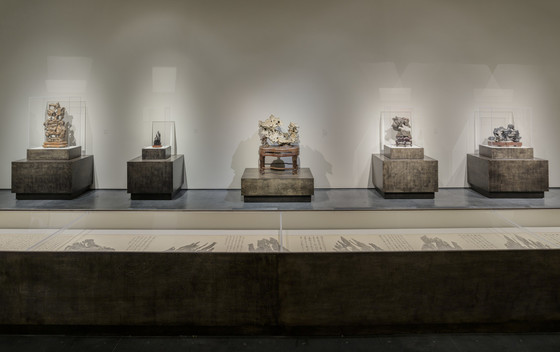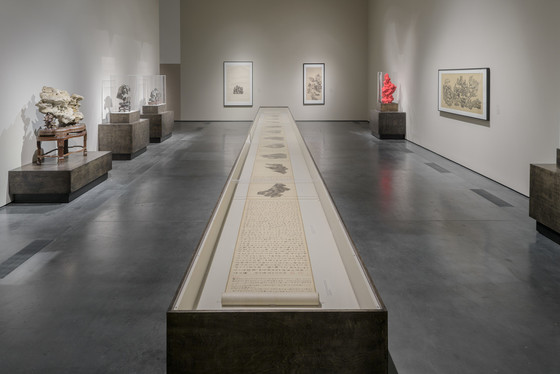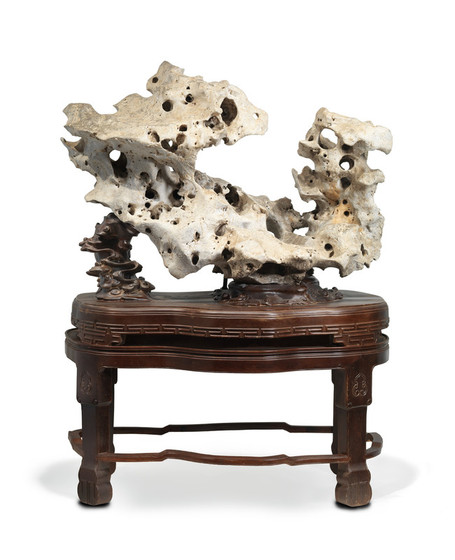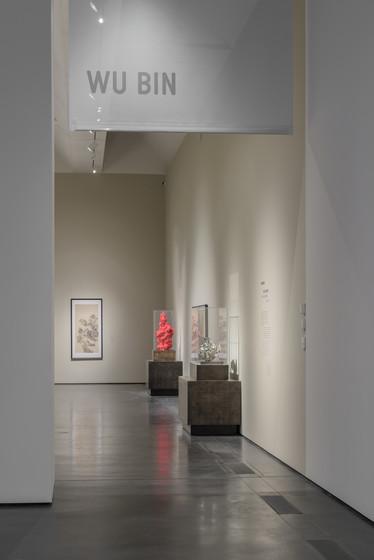In China strange stones (guai shi) were valued on several levels. While they could convey considerable social status merely through their strange beauty, stones were also seen as reflections of the basic structures underlying reality as understood by ancient Chinese philosophers and cosmologists. Many stones were perceived to be made of the purest energies left over from the creation of the world. As the Song dynasty (12th century) writer Kong Chuan wrote in his preface to Du Wan’s Stone Catalogue of Cloudy Forest, “The purest essence of the energy of the heaven-earth world coalesces into rock.”
It is clear from the classical Chinese literature on stones, dating to as early as the Tang dynasty (618–906), that stones were seen in this light—not as solid, fixed bodies, but as fluid and dynamic, capable of magical, supermundane transformations. Certain stones were believed to have the ability to speak, to emit clouds and rain, to predict the weather, to move about of their own accord, and to heal. Whether placed in gardens or interiors, such fantastic stones were perceived as mountains in miniature, imbued with the same primordial energies that made up the Five Sacred Peaks (Wu yue), the three island-mountains of the immortals in the Eastern Sea, and other peaks sacred to both Daoist and Buddhist traditions. Like the human body, stones and mountains were believed to be born, to live and to die. In strange stones the ancient Chinese witnessed the most fundamental structures and processes of the world, and found evidence that all things are in a continuous state of flux. A stone could conjure the presence of a sacred mountain in one’s home, for stones, like sacred peaks, were perceived as pure energies, momentarily (and deceptively) frozen into wondrous shapes. Such stones also symbolized the human virtues of strength and endurance.

In China fantastic stones—especially those with strange shapes—were already revered in remote antiquity, when they were said to have been presented as tribute gifts to Emperor Yu, a quasi-mythical sage-ruler. Collectors would pay as much for these stones as they would for a painting, or even an entire house or estate. These stones were also appreciated for the musical sounds they made when struck or tapped.
By the 9th century, in the Tang dynasty (618–906), a sophisticated literature of stones—both prose and poetry—had appeared. One of the most famous such poems, inspired by a great Taihu stone dredged from the depths of the Great Lake (Taihu) in Jiangsu province, was composed by poet Bo Juyi (722–846).
From afar one sees the crests of old peaks,
Up close one sees cliffs’ strange ridges.
Its lofty height—eight to nine feet,
[Yet] it feels like eighty million feet!
Its deep, empty valleys like the Cave of Floriate Yang,
Layer upon layer, like the peaks of Lofty Mount Lu.
Remote! Separated like the Immortal’s Palm,
Ha! Yawning wide as Sword Gate.
Its form spans present and past,
Its vital energy penetrates to the clear sky [above].
When autumn approaches, one hears the soughing of the wind,
When rain approaches, it’s dripping wet!
Its natural beauty truly extraordinary,
[Yet] its usefulness cannot be employed.
For sharpening knives, not as good as a whetstone;
For fulling silk, inferior to a fuller’s stone.
So what must the owner be thinking,
Valuing it as worth ten thousand in gold?
And how is it that its Creator [the Dao]
Alone can understand my heart?
(Translated by Stephen Little)
By the 11th and 12th centuries there were many famous stone collectors, including the Song dynasty emperor Huizong (r. 1100–1126). Mi Fu, a painter, calligrapher, and connoisseur who worked in Emperor Huizong’s court, was famous for encountering a great stone in his office courtyard, and bowing to it every morning, referring to it as his “elder brother.” Later emperors continued the practice of stone collecting, as one can see today in the imperial gardens within the Forbidden City.

The tradition of stone collecting reached its peak in the Ming dynasty (1368–1644), a period in which illustrated manuals of stone lore and connoisseurship flourished, and amazing portraits were painted of fantastic stones. This exhibition focuses on the most extraordinary painting of a stone ever created in China: Wu Bin’s Ten Views of a Lingbi Stone. This Ming handscroll, painted in 1610, comprises ten separate views of a single stone from Lingbi in Anhui Province, owned by the famous official and calligrapher Mi Wanzhong (1570–1628), the greatest stone collector of the Ming period. The handscroll, painted in ink on paper, was created at the behest of the stone’s owner by Wu Bin (c. 1543–c. 1626), a renowned landscape painter from Fujian Province.
Each of the stone’s 10 views is rendered in exceedingly complex brushwork. Fine lines twist, waver, and unravel in a seemingly infinite variety of movements, describing the continually shifting shapes of the stone’s jagged peaks, vales, crevices, and caverns. These intricate lines combine with subtle washes of ink to convey the sense that one is looking not at stone, but at flames, or pure energy. What is most amazing is that Wu Bin, like other Chinese ink painters, achieved such a broad and complex range of visual effects using such minimal technical means as brush and ink.

In the exhibition, on view in the Resnick Pavilion beginning December 10, Wu Bin’s extraordinary handscroll will be accompanied by several superb examples of Chinese Lingbi and Taihu stones (including a fabulous Taihu stone acquired by LACMA’s 2017 Collectors Committee, which will be on public view for the first time). In addition, the exhibition will include several works depicting stones by the contemporary ink painters Zeng Xiaojun, Yao Wing-feng, and Leung Kui-ting.
Wu Bin: Ten Views of a Lingbi Stone is on view in the Resnick Pavilion through June 24, 2018.



